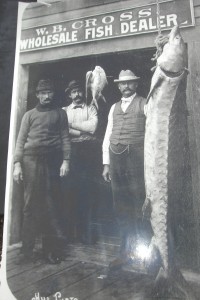Alright, sturgeon … they made your bed, now spawn in it.
Michigan organizations and agencies are building nine rock reefs in the Middle Channel of the St. Clair River to bolster native fish spawning and restore habitat. The Middle Channel of the river connecting Lake Huron to Lake St. Clair supports one of the largest remaining populations of sturgeon in the Great Lakes.

To give sturgeon more spawning grounds in the St. Clair River, organizations and officials are building underwater reefs made of limestone and fieldstone. Photo: Brian Bienkowski
Led by Michigan Sea Grant, the team will finish the nine reefs this week. Each will be about 40 feet wide, 120 feet long and 2 feet high. Made of angled limestone and rounded fieldstone, the reefs are an effort to return the river to a spawning hotspot — just like in the good ol’ days.
“This gives us a chance to bring back the sturgeon numbers … without stocking,” said Mike Thomas, lake sturgeon coordinator with the Michigan Department of Natural Resources, which is a project partner.
About a century ago, the St. Clair River and the Detroit River – which is between Lake St. Clair and Lake Erie – were straightened, widened and deepened for shipping. This harmed the places where fish spawn, as limestone and other rocks were displaced and damaged.
But the prehistoric-looking sturgeon, which can weigh between 30 and 100 pounds, still hang out in this Lake Huron to Erie corridor.
At the Blue Water Bridge, where Lake Huron spills into the St. Clair River, there are about 30,000 adult sturgeon, said Justin Chiotti, a fish biologist with the U.S. Fish and Wildlife Service, another project partner. There are about 15,000 in the Middle Channel and 3,000 to 5,000 in the Detroit River, he said.
Mike Thomas of the Michigan Department of Natural Resources explains what lake sturgeon populations tell us about the health of the Great Lakes. (Video: Brian Bienkowski)
Male sturgeon live about 55 years and females can live 80 to 150 years. These populations are important because the lakes aren’t getting sturgeon from other Michigan rivers.
There are no Michigan tributaries contributing sturgeon to Lake Huron, said Jim Boase, the Huron-Erie river corridor coordinator at the U.S. Fish and Wildlife Service.
A lot of the rivers feeding into Lake Huron can’t support sturgeon spawning because of dams.
And it’s the same story with those feeding Lake Erie, Boase said.

Rounded fieldstone.

Angular limestone.
The reefs are made of loose rocks piled up. A gentle slope down either side keeps sediment from accumulating. Fish eggs are protected by the gaps between the rocks. In addition to sturgeon, walleye and whitefish will benefit from the long piles of rocks, said Jennifer Read, the acting director and a research coordinator at Michigan Sea Grant.
The right rock size is important to keep away unwanted parasites.
“We had to make sure there was no rock less than 2 inches in diameter,” said Bruce Manny, a research fishery biologist with the U.S. Geological Survey, another project partner. “We didn’t want to provide sea lamprey spawning spots in the reefs.”

Sturgeon, and mustaches, used to be more common in the Great Lakes region. Photo: Brian Bienkowski (of a Michigan Sea Grant archive photo)
The two-year project is funded by $1,040,000 from federal Great Lakes Restoration Initiative grants. And this project may even get the St. Clair River off the dubious Great Lakes Areas of Concern list.
“One of the hardest beneficial uses to remediate is habitat,” said Paulette Duhaime, vice president of the St. Clair Area of Concern Binational Public Advisory Council.
The St. Clair River is on target to be delisted in 2014, Duhaime said.
“This is one of the projects that will make that possible.”
Reef success will be monitored by comparing spawning rates in the Middle Channel to places without the artificial beds. Researchers will see if adult fish are hanging out near the reefs, see how many eggs there are and monitor the health of young fish.
But there is confidence that the reefs will work.
“I think it’s pretty much a no-brainer,” said Terry Heatlie, a habitat restoration specialist with the National Oceanic and Atmospheric Administration, another project partner. “This area will have a lot of fish spawning in it.”
And for sturgeon lovers, that is great news.
“Sturgeon are just amazing,” said Jim Felgenauer, president of the St. Clair-Detroit River Sturgeon for Tomorrow organization.
“I can catch a sturgeon and 20 to 40 years from now, my grandson can catch the same fish,” he said. “Now that’s special.”
